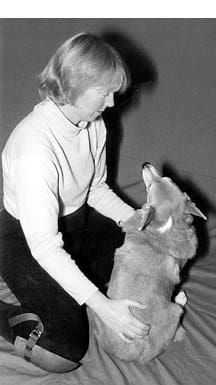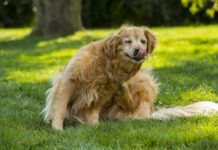In the last issue, we discussed the importance of effleurage for increasing circulation and preparing muscles for deeper work. Effleurage is often followed by one of several petrissage techniques. Petrissage is another French term that means “to mash or to knead.” Unlike effleurage, the hands do not slide over the tissues. Instead, the tissue is lifted from underlying structures or compressed against them. Also known as “digital circles” or “digital kneading,” this is a very common and useful petrissage technique.
To perform digital circles, hold the hand in a loose cupped position with fingers spread. Contact the coat with finger pads (not finger tips) and make a slow clockwise circular motion. Your touch can be firm, but do not pinch the tissues. The technique increases circulation, relaxes muscles, and loosens adhesions.
It is also an important technique for learning about your dog’s muscles. Go slowly and listen to the messages your finger pads send concerning the texture of the muscle and the presence of spasms, knots, tight spots, depressions, and cool or hot spots. Special attention to these areas with slow gentle digital kneading should help relieve these conditions.

Hands-on how-to
Putting it all together takes a little planning, but can provide a massage session for your dog that may address some problems like sore muscles or spasms and will certainly promote relaxation and reduce stress.

Start by preparing a place for the massage. A small dog can be placed on a sturdy table that is at a comfortable height for you. Be sure the table has a nonskid surface or cover it with a rubber-backed throw rug so the dog doesn’t slip. Large dogs are usually most conveniently massaged on the floor. You can place a large, clean, rubber-backed throw rug in a quiet, comfortable part of your home. This gives the dog a sense of the area that you have set aside for the massage, and it provides a cushion for your knees as you kneel to work. Some folks like to use gardeners’ knee pads for comfort.
Continually be aware of the position of your body. Keep your back straight and your legs in a comfortable position. Don’t get so involved with working on the dog that you finish the session with a stiff back or a cramp in your legs.
When you are ready, greet your dog and let him know that a special treat is in store. Set your intention for the good of the dog and begin. Your dog can remain standing if that is most comfortable for him or he can stretch out. Even dogs that start a massage session on their feet often melt to the floor as they relax to your touch.
Opening act
You should “open” each body region with effleurage. Start with the face and head and stroke gently to increase circulation and bring oxygen and nutrients to the tissues. Three or four effleurage strokes are sufficient to open the area. Using gentle pressure, make a number of digital circles on the large masseter or jaw muscle. Most dogs find this very relaxing – but if your dog is uncomfortable with this or any other area of her body, move along to the next area; don’t feel compelled to correct her in any way. Remember, this is about her comfort.
Then move on to the ears. Continue with a series of slow, gentle digital circles starting in front of the ear and move on in a path around the entire base of the ear. Both sides of the head can be done or you can wait and massage the other side when you move to the other side of the body. When you have completed working on the face and head, “close” the area with effleurage to move toxins out of the area.
Continue the effleurage along the neck and the length of the spine to open this area. One-handed effleurage is fine for a small dog while two-handed effleurage is probably better suited to a large dog.
Next, locate the vertebral column. Work on the muscles to the side of the vertebrae (never on the vertebrae!) and begin a long series of digital circles starting at the neck and continuing to the tail. This is more than a mechanical exercise. Your finger pads should be like eyes searching for spasms, knots, cool or hot spots, depressions, or bumps in the muscles. GO SLOWLY! It takes time to really “see” what is going on in the muscle you are touching. Always keep your second hand on the dog to monitor changes in general muscle tension or changes in the body. Using light pressure, gently continue digital circles in problem areas. Once you have reached the tail, you may wish to move a half inch farther from the spine and make a second series of digital circles. On a large dog, a third pass of digital circles slightly farther out is appropriate. Complete the work along the spine by closing with effleurage.
Now you can use effleurage and digital circles on the limbs. First effleurage up the front leg. Digital circles on the large muscles of the upper limb can relieve tightness there. Around the elbow joint, digital circles can identify swelling or tenderness and may reduce stiffness by relaxing the muscles around the joint. Support the limb with one hand if the dog is lying down. Close the forelimb with effleurage from the toes toward the shoulder.
Massage of the rear limb is similar. Open with effleurage from the toes toward the hip, than use digital circles to relax and relieve any spasms or knots in the large hip and upper leg muscles. Support the limb with one hand and massage the stifle. Close with upward effleurage.
With massage on one side complete, it is time to ask the dog to roll over so you can repeat the moves on the other side. It is often necessary to coax a large dog to stand so you can reposition him to work on the other side. Once the massage is complete, be sure to thank the dog. He may express his appreciation with kisses and a tail wag or he may show it by taking a long snooze.
By C. Sue Furman
Author Sue Furman is an Associate Professor in the Department of Anatomy and Neurobiology at Colorado State University in Ft. Collins, CO. She is also active as a free-lance writer and teaches equine and canine massage classes. This article is adapted from material in her new book, Canine Massage, that will be available in spring 2000.






